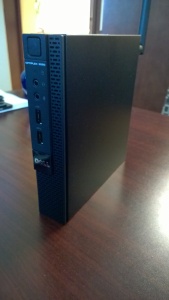While not having published anything in a little while, I have been seriously testing Windows 10 in all it’s various forms over the past six weeks or so. As anyone reading this blog knows, I’m on the fence about Windows 10 because of the various compromises in what I think were useful features in Windows 8.x, but pretty enthusiastic about it on the desktop.
It’s pretty much the eve of RTM, any day now Microsoft will sign off on the first shipping version of Windows 10, if that actually means anything in the ‘Windows as a Service’ world. The current build is 10166 for insiders. Has anything improved for the tablet user? A little, but not really enough.
The good news is that as the builds get closer to RTM, the stability has gone way up, so much so that I moved my work desktop to it a few builds back. I also have it on a home ‘guest pc’ desktop that’s an older unit, a touch based notebook, and on a Dell Venue Pro 8 which I use for tablet testing of the UI. The two desktop machines are now running perfectly. Seriously, no lie. Issues from the past seem to be gone, it’s fast (even on the old PC). Driver issues are gone, all our weird line of business apps work, even login to a domain is working faster now. I even slapped on a cheap fingerprint reader on my work PC to test Windows Hello! (that still seems like a Seinfeld joke to me). Smooth as silk. I love it on the desktop.
Let me say that again, I love it on the desktop. Got a desktop? Do the upgrade. Unless you have Media Center, then well, I feel you. I have one PC that won’t make the leap because it’s just too valuable as a TV. But everyone else? Do it!
The not so good news is that on a tablet, Microsoft seems to have conceded the market. It’s a tablet in form only. There is a taskbar that takes up space, clutters the interface, and has icons to small for anyone but my four year old niece can use. There’s the ‘what I consider broken’ task switcher, that makes it impossible to flip through applications like Windows 8.x. There is the Action/Notification thing that replaces Charms but provides no Windows button or has icons you can access with thumbs, and just accumulates status of new mail (I have yet to see a notification that wouldn’t have been better receiving another way). There are the new ‘universal’ apps that basically look like Android. And that’s the thing, Windows tablet mode is basically Android. I can’t hold the device on the sides and use it like before. Everything requires two hands, icons are small (too thin to see in some cases), washed out with too much white titlebar, and no attention to detail.
Is it a disaster?
No, it’s meh. Like Android. It’s dishwater dull. It’s not designed anymore, it’s whatever your app slaps on the interface and run. There’s no edge UI of any consequence (that used to be useful, now it’s just clunky). Everything tablet has been deprecated in favor of the desktop. That’s Microsoft basically throwing in the towel and giving up to the iPad (which, low and behold now has flip switching and snap multitasking like Windows used to).
Apple and Android are picking over the dead carcass of good ideas Microsoft had and incorporating them into their platform while Microsoft is busy adding a freaking taskbar to a tablet.
But is it good enough? Yeah, it’s okay. A solid 5 out of ten. Woot. And since all the new apps that will now flood onto the platform because it has a taskbar and start menu (yes I’m being facetious) well, I have to have something that will run them. So my strategy is to give it a go on one Surface Pro and see if I can stand it. The Dell might be too small and tainting my opinion. I’ll see if I can adjust, or at least not trash it all and buy an iPad. If that works I might use it on my brand new Surface 3 or even my beloved Toshiba Encore 2 Write. But only maybe. Now it depends on apps more than anything.
On Windows 8.x it was the experience of the OS, the fluidity, the ease of use, and cool factor that made me love the devices (and put up with the distinct lack of applications). It made me willing to embrace third party apps, pin websites, and do without some basic things other platforms had. It made me get my XBOX Music pass (which I love and never would have had before). It made me buy an Xbox One. It reaffirmed my love for Windows Phone. I was ‘all in’. Now all bets are off–they’ve taken away all the things I liked and made Windows a me-too tablet/desktop thing that’s middling at best (but again, simply GREAT on a desktop). Now it IS the apps that will make a difference, those will have to carry the value of Windows devices where Windows used to. Now I have a critical eye. Now there are no excuses.
Microsoft has turned this total fan into a much more on the fence guy. But that’s another post coming soon :-).


You must be logged in to post a comment.